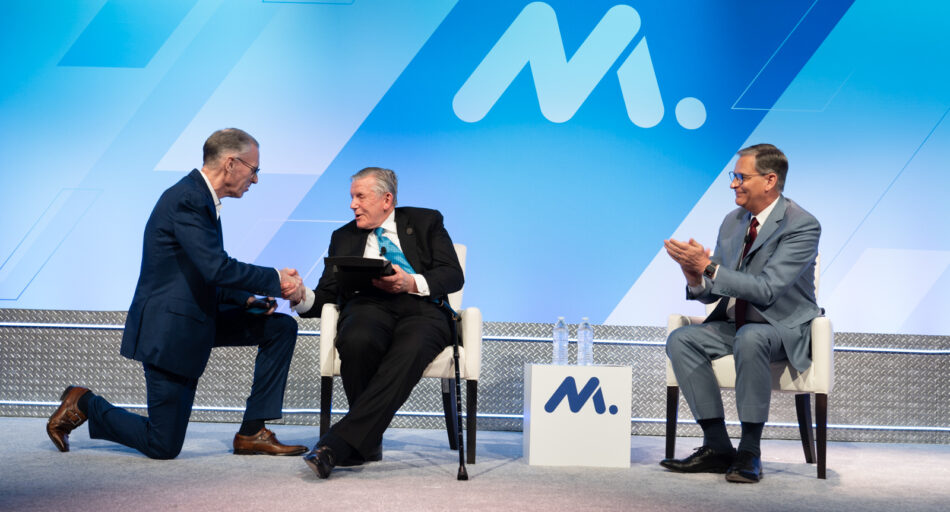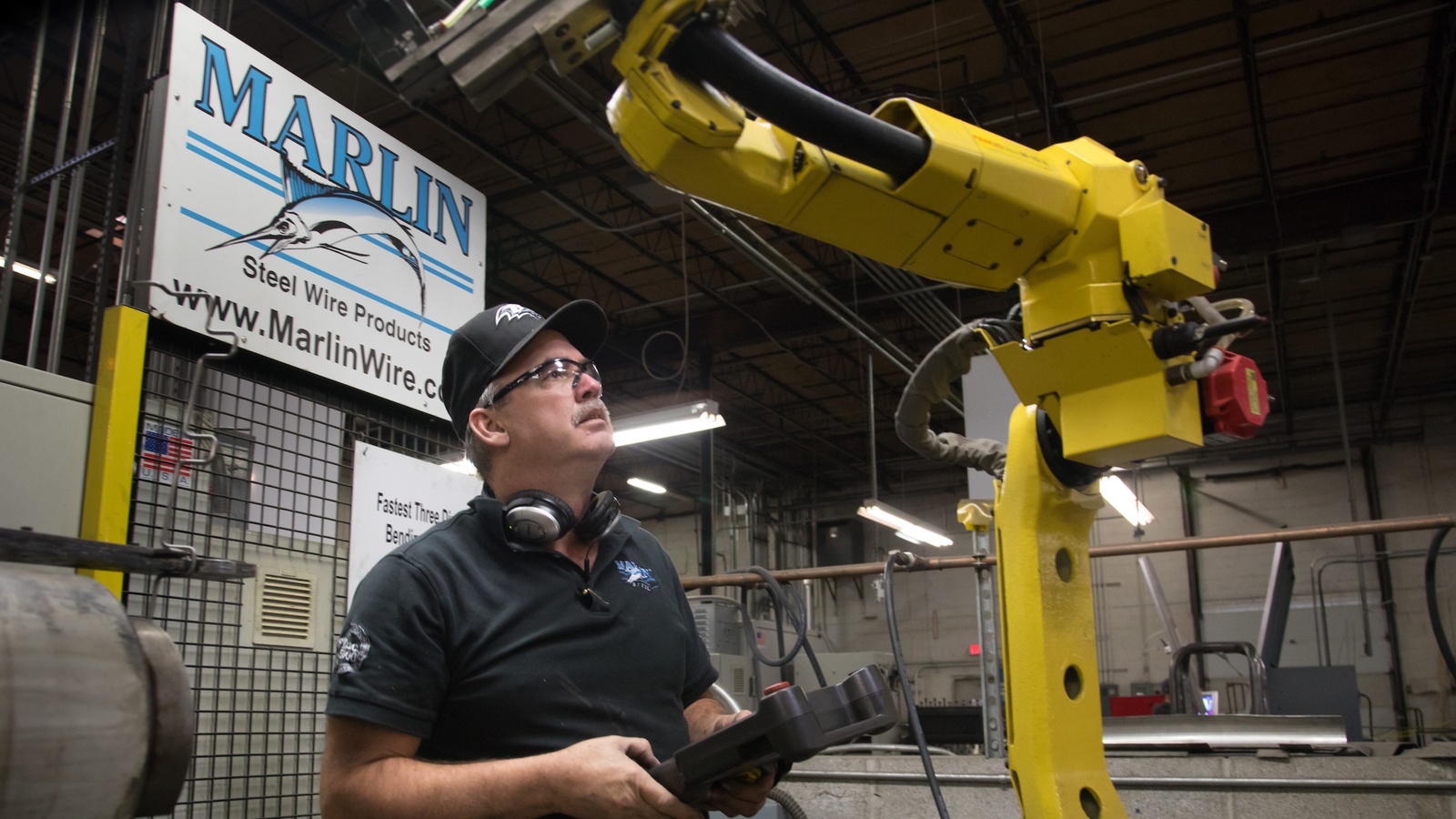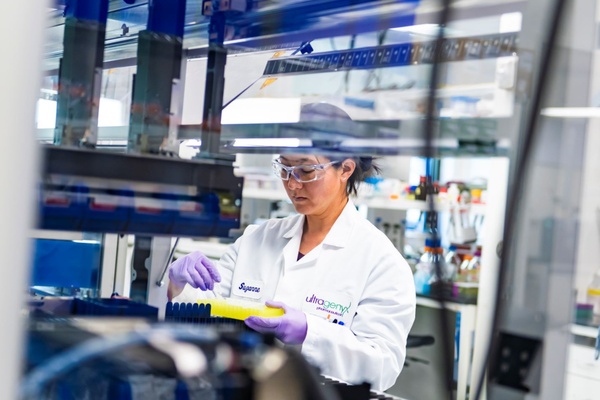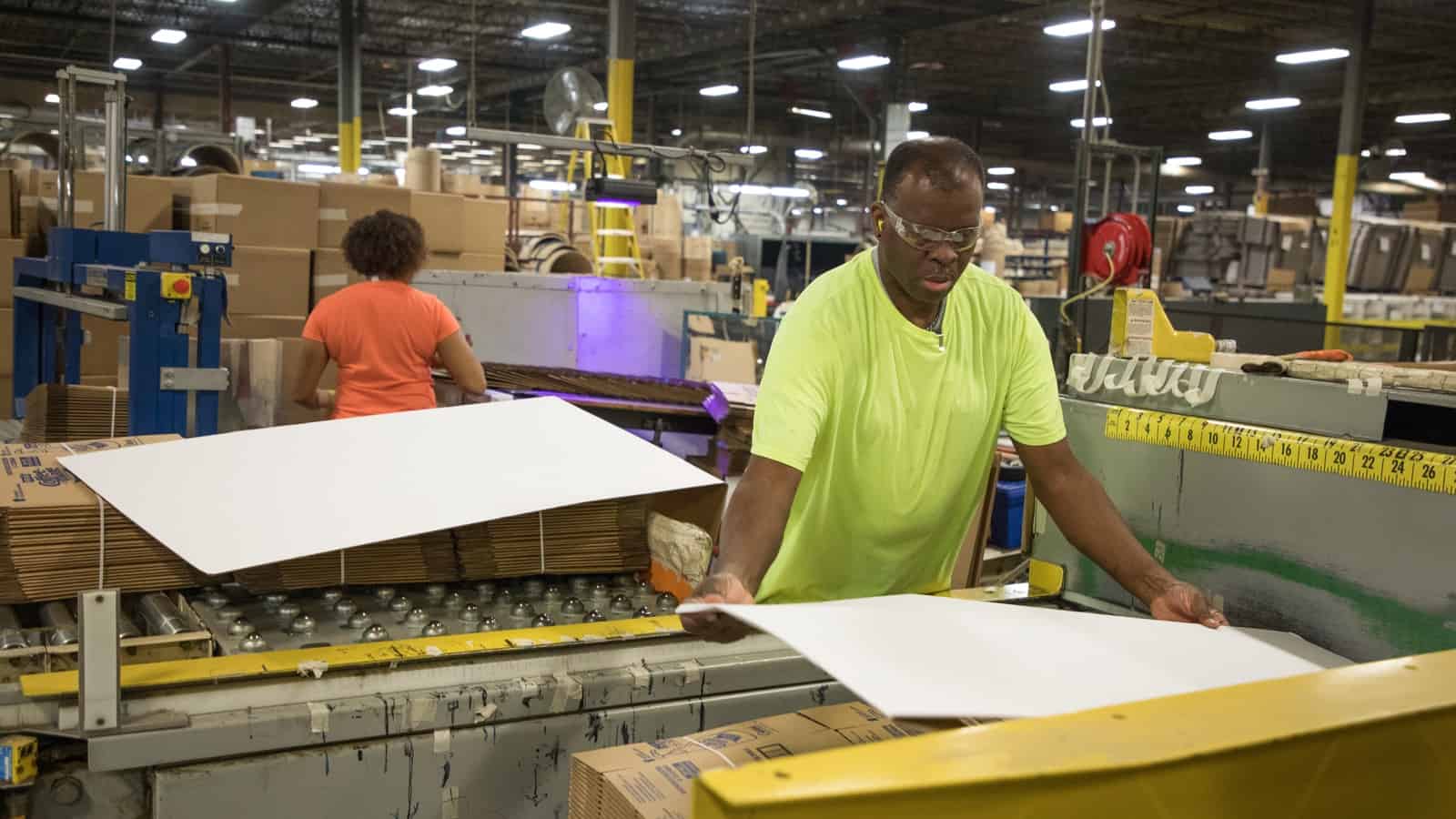NAM Speaks Out Against New EPA Regulations

Manufacturers across the United States have long been leading the way on sustainability. From outpacing international competitors on emission reductions to making investments in clean technologies, the industry has implemented best practices for others to use and blazed a trail for them to follow.
NAM Director of Energy and Resources Policy Chris Morris emphasized manufacturers’ track record during a hearing before the Environmental Protection Agency last week, where he explained to policymakers that their proposed air quality rules would stifle rather than enhance manufacturers’ efforts. Here’s what he had to say.
A record of leadership: “Our industry has championed environmental stewardship at every turn, and our members have invested heavily in new processes and technologies that have made manufacturing in the U.S. cleaner and more sustainable than ever,” said Morris.
- “This innovation in the manufacturing sector has played a key role in the reduction of air pollution we have seen over the last 50 years.”
Manufacturers’ impact: “Across the board, levels of major pollutants have declined dramatically, and we are outpacing our global competitors in air quality improvements,” said Morris.
- “According to the EPA, the U.S. has reduced six common NAAQS pollutants, including PM2.5, by 78% between 1970 and 2020.”
- “Additionally, EPA data shows that PM2.5 air quality has improved 44% since 2000. Manufacturers are committed to ensuring that progress continues.”
The challenge: New proposed regulations from the EPA would have a number of negative effects, Morris noted.
- Tighter air quality standards would make permitting more difficult, raise compliance costs and make it harder for manufacturers in the United States to compete with companies abroad—especially at a time when manufacturers are concerned about the country’s economic outlook.
The path forward: Morris urged policymakers to ensure that current regulations are fully implemented before they propose new ones, and to work together with innovative manufacturers on smart solutions.
- “The U.S. has some of the best environmental standards in the world, and American manufacturers are consistently reducing emissions, conserving critical resources, protecting biodiversity, limiting waste and providing safe products and solutions so others in our country can do the same,” said Morris.
- “But in order to maintain our environmental leadership, we need better regulations.”
The last word: “In our view, environmental protection and a thriving economy are not mutually exclusive,” said Morris. “We can have both—but it requires working together toward a constructive solution. Manufacturers are committed to smart, strong environmental safeguards and improving the lives of all Americans so that no one—and no community—is left behind.”
NAM Honors Snap-on CEO Nick Pinchuk for Extraordinary Commitment to Manufacturing in America

Boca Raton, FL—The National Association of Manufacturers today honored NAM board member and Snap-on Chairman and CEO Nick Pinchuk with the Manufacturing Icon Award during the NAM’s spring board meeting in Boca Raton, Florida. The award recognizes leaders who inspire Americans to promote, perpetuate and preserve manufacturing in America.
“Across the industry and across the business community, executives and employees alike look up to Nick Pinchuk. His storied career is a source of inspiration, and he is a wealth of knowledge, a wise counselor and a tireless advocate for the rewarding careers found in modern manufacturing. He has been a tremendous supporter of the NAM and the Manufacturing Institute’s Creators Wanted campaign to build the manufacturing workforce of today and tomorrow, and his policy advocacy on behalf of the industry is best-in-class,” said NAM President and CEO Jay Timmons.
“His presence on television and in the public eye as a principled manufacturing leader, as well as his unwavering service to the NAM and to our industry, makes Nick a true model for business leaders in America. In whatever he does, he demonstrates an unshakeable commitment to the values that have made our country exceptional and keep manufacturing strong: free enterprise, competitiveness, individual liberty and equal opportunity. We’re honored to present this award to Nick in recognition of his outstanding leadership.”
Pinchuk serves on the NAM Executive Committee as the NAM tax, domestic economic and regulatory reform policy vice chair and on the board of directors of the Manufacturing Institute, the workforce development and education partner of the NAM.
-NAM-
The National Association of Manufacturers is the largest manufacturing association in the United States, representing small and large manufacturers in every industrial sector and in all 50 states. Manufacturing employs more than 13 million men and women, contributes $2.81 trillion to the U.S. economy annually and accounts for 55% of private-sector research and development. The NAM is the powerful voice of the manufacturing community and the leading advocate for a policy agenda that helps manufacturers compete in the global economy and create jobs across the United States. For more information about the NAM or to follow us on Twitter and Facebook, please visit www.nam.org.
Manufacturers: Find Our Open Jobs and Pathways to Careers at CreatorsWanted.org
Amid a workforce crisis, the National Association of Manufacturers and the Manufacturing Institute partner with FactoryFix to launch a new resource
Washington, D.C. – With the number of manufacturing job openings in the United States averaging 830,000 per month over the past year, the National Association of Manufacturers and the Manufacturing Institute have partnered with FactoryFix to launch and power Creators Connect, a new digital career resources platform designed to help students, parents, career influencers and job seekers easily explore and pursue the wide range of pathways available in modern manufacturing.
“Addressing the workforce crisis is among the top concerns for manufacturers across the country,” said NAM President and CEO and Manufacturing Institute Board Chair Jay Timmons. “While we cannot fully solve this challenge without immigration reform, manufacturers are determined to lift up more people in the United States with the promise and reward of modern manufacturing careers—and Creators Wanted’s new digital career resources platform is another way that manufacturers are leading with solutions.”
Creators Connect is the first and only unified platform to search and explore career pathways, job openings and job training programs across the entire manufacturing industry while making it easier for manufacturing professionals to attract and identify talent to fill the skills gap.
“We’ve made tremendous strides in inspiring a new generation of manufacturers at the Manufacturing Institute and across the industry, but what’s been missing is a single resource for manufacturing jobs and pathways opportunities,” said MI President Carolyn Lee. “Today, we bring an unmatched tool—in terms of volume and quality of jobs—to help us close the skills gap and change more misperceptions about modern manufacturing.”
Creators Connect is live on CreatorsWanted.org, home of the NAM and MI’s Creators Wanted campaign, which is the largest industry campaign to build the workforce of today and tomorrow. Since 2021, Creators Wanted has built an email network of more than 1 million students, early career entrants and potential career influencers. FactoryFix is already the leading manufacturing recruitment platform in the U.S., hosting more than 400,000 job openings and having its own talent network of more than 650,000 manufacturing workers. The partnership is the first of its kind for the industry’s largest and oldest manufacturing trade association.
“It’s an incredibly exciting opportunity for FactoryFix to be the engine behind Creators Connect and a part of the Creators Wanted campaign,” said FactoryFix CEO and Founder Patrick O’Rahilly. “As a one-stop recruiting solution for manufacturers to find qualified and engaged candidates, we’re looking forward to increasing our impact in addressing the labor shortage and helping more Americans create their future in modern manufacturing.”
By powering Creators Connect, FactoryFix representatives will join the NAM and the MI’s Creators Wanted workforce campaign as it continues its roadshow in 2023 and expands its digital campaign across the United States. By 2025, Creators Wanted aims to recruit 600,000 new manufacturing team members; increase the number of students enrolling in technical and vocational schools or reskilling programs by 25%; and increase the positive perception of the industry among parents and career influencers to 50% from 27%.
To explore Creators Connect, visit CreatorsWanted.org.
-NAM-
The National Association of Manufacturers is the largest manufacturing association in the United States, representing small and large manufacturers in every industrial sector and in all 50 states. Manufacturing employs more than 12.9 million men and women, contributes $2.81 trillion to the U.S. economy annually and accounts for 55% of private-sector research and development. The NAM is the powerful voice of the manufacturing community and the leading advocate for a policy agenda that helps manufacturers compete in the global economy and create jobs across the United States. For more information about the NAM or to follow us on Twitter and Facebook, please visit nam.org.
-Manufacturing Institute-
The MI grows and supports the manufacturing industry’s skilled workers for the advancement of modern manufacturing. The MI’s diverse initiatives support all workers in America, including women, veterans and students, through skills training programs, community building and the advancement of their career in manufacturing. As the workforce development and education partner of the NAM, the MI is a trusted adviser to manufacturers, equipping them with resources necessary to solve the industry’s toughest challenges. For more information on the MI, please visit https://www.themanufacturinginstitute.org.
-FactoryFix-
FactoryFix is the leading recruitment automation solution for manufacturing companies, combining the power of a talent network with specialized recruitment technology. Our platform helps HR manufacturing teams save time and budget by automating tedious tasks, streamlining recruitment efforts and providing a consistent flow of engaged candidates.
Founded in 2017 in Chicago, Illinois, FactoryFix has nearly 650,000 manufacturing professionals in its talent network and is the exclusive recruiting partner of the National Association of Manufacturers, Manufacturing Institute and Creators Wanted. Hundreds of the top manufacturing companies in the country trust FactoryFix to help meet their hiring goals. For more information, please visit https://www.factoryfix.com.
How a Tax Change Will Strangle a Small Manufacturer’s R&D

Marlin Steel Wire Products spent its first 30 years making bagel baskets. When Drew Greenblatt bought the custom wire and metal fabrication company in 1998, he thought it would be making bagel baskets for the next 30 years as well—but soon, international competition changed the math.
“Suddenly, China started manufacturing bagel baskets and shipping them to New York City for cheaper than I could get the steel,” said Greenblatt, Marlin’s president and owner. “But then, we got a phone call from an engineer at Boeing who needed an innovative, customizable basket. And that was the eureka moment.”
The shift: Greenblatt recognized that innovation would help him outcompete foreign companies that could manufacture products more cheaply.
- “We realized we couldn’t thrive in a commodities market,” said Greenblatt. “We had to come up with novel ways to make a basket so that it would make no financial sense to buy from China or Mexico.”
- “We wanted to be able to say to buyers, you must buy from the American innovative company, because we’re coming up with such slick ideas that our product blows the competition away.”
The growth: Today, Marlin Steel is nearly 30 times larger than it was when Greenblatt bought it and heavily invested in research and development.
- “Today, Marlin is 15% degreed mechanical engineers,” said Greenblatt. “We have chemical engineers. We’re coming up with the most innovative racks and systems out there.”
- “People are showing us their operations and asking us to reverse-engineer solutions that will work for them. And we’re doing it.”
However . . . A recent tax change threatens to throttle the company’s progress. Until about a year ago, businesses could deduct 100% of their R&D costs in the same year they incurred those expenses.
- But since last year, a tax policy change now requires businesses to spread their R&D deductions out over a period of five years, making it much more expensive to invest in innovation.
The impact: “Our taxes will be $600,000 higher than they should have been this year—we’ll pay four and a half times more on taxes,” said Greenblatt.
- “What that means is that it makes sense for us not to hire six more engineers. Not to buy three more press brakes [machines for bending metal parts] or hire people to work them. It’s incredibly shortsighted, a horrible policy screwup, and the ripple effects are massive.”
The scope: Greenblatt also emphasizes that the tax change will harm many small businesses.
- “People tend to focus on the bigger companies and how it will hurt them—and it will hurt them—but it will also hurt the little guy,” said Greenblatt. “And the little guy is the job creator in America.”
The last word: “American innovation—that’s our secret sauce,” said Greenblatt. “That’s how we’re going to grow jobs and pay people well and give good benefits and steady employment without layoffs. That’s how we’re going to beat a recession. We need to have the coolest, most innovative products in the world. For us, innovation is key.”
NAM Launches 2023 Competing to Win Tour
President and CEO Jay Timmons to Deliver the NAM State of Manufacturing Address
Washington, D.C. – The National Association of Manufacturers will kick off its 2023 Competing to Win Tour on Tuesday, Feb. 21, 2023, traveling to three states and visiting four manufacturing facilities along the way.
The tour will begin in Wisconsin, where NAM President and CEO Jay Timmons will deliver the 2023 NAM State of Manufacturing Address at Husco.
Throughout the week, Timmons will join local manufacturers, employees, media, community leaders and elected officials to discuss the challenging environment facing manufacturers and the urgent need for solutions on issues including immigration reform, permitting reform, workforce development, tax policy and more.
The tour comes as nearly two-thirds of manufacturers are concerned about the challenging economic environment characterized by inflation, supply chain disruption and the workforce crisis, according to the NAM’s latest Manufacturers’ Outlook Survey. More than three-quarters of respondents said pushing back against regulatory overreach should be the top priority of the 118th Congress.
“Our focus on this tour is telling the story of resilient, modern manufacturing—and the tools we need from policymakers to continue leading our economy forward and making the world a better place,” said Timmons. “To unleash our full potential, we need to reinstate critical tax provisions, a smarter, balanced approach to regulations, immigration reform and significant permitting reform, and reject top-down air regulations that cost jobs and snarl supply chains.”
For more than a decade, the annual NAM State of Manufacturing Address has focused the nation’s attention on the industry that is the backbone of the American economy, highlighting the 13 million men and women who are building our future.
The NAM has frequently traveled the country, bringing policy discussions and conversations about the future of work to shop floors, schools, economic clubs, televisions studios, the White House and more.
At a time when the future of work is top of mind for workers and thought leaders alike, the tour will also spotlight the industry’s rapid transformation, while also focusing on manufacturing’s well-paying careers, the industry’s diverse workforce and the real-world solutions for manufacturing’s continued growth.
Tour events will take place in Wisconsin, Indiana and Louisiana. Details are as follows:
Tuesday, Feb. 21 // Wisconsin
8:30 a.m. – 10:30 a.m. CST
Husco
2239 Pewaukee Road
Waukesha, Wisconsin 53188
11:00 a.m. – 12:00 p.m. CST
Waukesha County Technical College
800 Main Street
Pewaukee, Wisconsin 53072
Wednesday, Feb. 22 // Indiana
9:00 a.m. – 11:00 a.m. EST
INCOG BioPharma Services
12050 Exit 5 Parkway
Fishers, Indiana 46037
Timmons will be joined by Sen. Todd Young (R-IN)
Thursday, Feb. 23 // Louisiana
8:30 a.m. – 10:00 a.m. CST
Laitram
200 Laitram Lane
Harahan, Louisiana 70123
2:00 p.m. – 3:30 p.m. CST
McIlhenny Company
Highway 329
Avery Island, Louisiana 70513
MEDIA RSVP: Members of the media interested in covering the tour or attending an event should contact [email protected].
-NAM-
The National Association of Manufacturers is the largest manufacturing association in the United States, representing small and large manufacturers in every industrial sector and in all 50 states. Manufacturing employs nearly 13 million men and women, contributes $2.81 trillion to the U.S. economy annually and accounts for 55% of private-sector research and development. The NAM is the powerful voice of the manufacturing community and the leading advocate for a policy agenda that helps manufacturers compete in the global economy and create jobs across the United States. For more information about the NAM or to follow us on Twitter and Facebook, please visit www.nam.org.
NAM Pushes Back on Harmful New Air Regulations

Manufacturers have long led the way in efforts to reduce air pollution and improve air quality. Yet, new proposed regulations from the federal government will work against these efforts instead of bolstering them, stymying critical progress and destabilizing economic growth at a time when both are more important than ever.
The challenge: The Environmental Protection Agency is considering a new rule that would impose stricter air standards on particulate matter known as PM2.5 (i.e., particles that measure two and a half micrometers or less in diameter). This rule would enact significant top-down restrictions, forcing manufacturers to change their operations abruptly and without any support.
The reality: For years, manufacturers across all sectors have been developing smart, innovative ways to use energy, water and other resources more sustainably—all while boosting economic growth and creating good jobs at the same time.
- Today, manufacturing in the U.S. is cleaner and greener than at any other time in history, largely due to a revolution in how manufacturers produce, use and recycle energy and resources.
- Across the board, levels of major pollutants have declined dramatically over the past few decades. Thanks to existing regulations and a culture of innovation, the U.S. is far outpacing global competitors in environmental stewardship.
By the numbers: According to the EPA, the U.S. reduced six common pollutants covered by National Ambient Air Quality Standards, including PM2.5, by 78% between 1970 and 2020. In fact, PM2.5 levels alone have dropped a full 44% since 2000.
The impact: These new regulations could be devastating for manufacturers and for the climate. Here are just a few of the negative repercussions:
- An additional regulatory burden on businesses will drain resources from innovative manufacturers, posing additional hurdles to the investment in research and development that fuels progress in energy efficiency and climate action.
- Making permitting harder could also jeopardize new clean energy projects that America needs to address climate change.
- The standards will hinder onshoring, resulting in continued manufacturing abroad—which is less clean than manufacturing in the U.S. The EPA’s proposal undercuts U.S. competitiveness and will not further the goal of global emissions reduction.
- New regulations could damage an already-slowing economy, increasing costs and constraining job growth at a time when Americans are grappling with record inflation.
Our view: Rather than imposing new and unnecessary obligations on manufacturers, the federal government should focus on enforcing the strong regulations that are already in place and give manufacturers the space to find better solutions.
- “The EPA’s announcement . . . [about reconsidering] the PM 2.5 standard will only further weaken an already slowing economy,” said NAM President and CEO Jay Timmons. “Let manufacturers do what they do best: innovate and deploy modern technologies to protect the environment, while creating jobs and strengthening the economy.”
NAM in action: The NAM is rallying manufacturers to speak out against the EPA’s proposal and calling on Congress to oppose these harmful regulations.
- Manufacturers can show their support by sending an email to decision makers in Washington, explaining the real impact of this damaging proposal and urging them to stand up against unnecessary regulations.
Join in: There is an EPA hearing to discuss the proposal on Feb. 21. To participate, be sure to sign up soon—the registration deadline is Feb. 16.
Ultragenyx Fights for Cures Amid Rising R&D Costs

About 30 million people in the United States have a rare disease, according to the National Institutes of Health, which equates to about one in every 10 individuals. Approximately 95% of these rare diseases have no treatment at all—and Ultragenyx, a biopharmaceutical company focused on new and effective therapies for patients with rare and ultra-rare diseases, is working to change that.
- “In the aggregate, rare is not that rare,” said Ultragenyx Executive Director of Public Policy and Public Affairs Lisa Kahlman. “Half of those 30 million people are children. It’s a huge unmet medical need.”
Founded in 2010, Ultragenyx has four commercial products, with about 20 more in pre-clinical and clinical development. But a new change in tax policy poses a very real threat to Ultragenyx’s ability to develop as many treatments for rare diseases as possible.
The issue: Until a year ago, businesses could deduct 100% of their R&D expenses in the same year they incurred the expenses. Starting in 2022, however, a tax policy change requires businesses to spread their R&D deductions out over a period of five years, making it more expensive to invest in growth and innovation. For research-heavy companies like Ultragenyx, that change could divert funds intended for the development of therapies toward tax obligations.
- “Ultragenyx is different,” said Kahlman. “There are a lot of companies that do some work in rare diseases, but usually that’s only a fraction of what they do. We’re exclusively built to focus on rare and ultra-rare diseases, and that requires research.”
The impact: As a small, largely precommercial start-up company that focuses on research, Ultragenyx spends about 70% of its total operating expenses on R&D. In 2021, Ultragenyx spent approximately $497 million on R&D—nearly $150 million more than it earned in revenue.
- If the tax change stands, the company’s financial statement losses, which approximate decreases in the company’s cash reserves, will be adjusted for tax purposes to reflect significant taxable income, resulting in very large tax liabilities over a short period of years.
- This will occur during late stages of the company’s development programs just when costs escalate quickly. Altogether, money will be diverted to taxes and away from critical development programs at precisely the wrong time.
The human cost: If Ultragenyx and other research-heavy biotech companies that are focused on developing treatments for rare diseases must divert funds away from development and toward covering tax obligations, patients living with rare diseases will have even more limited options.
The bottom line: “The therapies we’re developing are really transformational, but in some cases, there might be only about 200 patients in the developed world with one of these diseases—so if we don’t have the money for R&D, there won’t be any incentive for anyone else to develop treatments,” said Kahlman. “For these patients, there is no alternative.”
Our move: At the NAM, we’re pushing Congress to reverse this change and allow manufacturers to invest in jobs, communities and innovation. Learn more and take action at www.nam.org/protect-innovation.
Why R&D Matters to International Paper

Innovation is getting more expensive—and that should worry all of us.
Until recently, businesses could deduct 100% of their R&D expenses in the same year they incurred those costs. But a tax law that took effect at the beginning of 2022 requires businesses to spread their deductions out over five years instead, driving up the cost of the innovations that keep our economy strong.
At International Paper—an American supplier of renewable fiber-based recyclable packaging and pulp products—that change is causing serious challenges. We spoke to Vice President of Finance and Corporate Controller Holly Goughnour and Senior Director for Government Affairs Kaitlin Sighinolfi to learn more.
Why it matters: “Our company invests in R&D for two main reasons: making better products for our customers and creating safer, more efficient and sustainable manufacturing processes,” said Goughnour.
- “We spend a lot of time and money working to make a better performing, more sustainable and more durable product, but innovation is about more than the product—it’s also about improving the safety and efficiency, and reducing the environmental impact, of our operations.”
The scale: International Paper devotes a significant portion of its resources to innovation, and as a result, the change in tax law has an outsized impact.
- “Much of our free cash flow goes to R&D activities,” said Goughnour. “The change in tax law has resulted in a significant amount of additional cash taxes in this first year, reducing the amount of capital available to invest back into our business, including additional R&D.”
The competition: Goughnour and Sighinolfi also emphasized the need for a tax system that helps manufacturers in the U.S. to compete with companies abroad. According to Goughnour, the new tax change does the opposite.
- “The new tax law enables European and Chinese competitors to accelerate their R&D faster than us,” said Goughnour. “We’re in a global marketplace, and the new tax law puts U.S. manufacturers at a competitive disadvantage.”
- “Almost nobody else in the world has this policy,” said Goughnour. “R&D is an absolute growth engine for the U.S. economy. Why would we have a tax policy that discourages investment in R&D? It makes no sense.”
The last word: “Ours is a supply chain story,” said Sighinolfi. “Innovation should be part of the overall manufacturing value chain, but the new law reduces the value of innovation, slowing investment in innovation and ultimately hurts American businesses, employees and consumers.”
Creators Connect Launched
As part of the Creators Wanted campaign, the NAM and the Manufacturing Institute have partnered with FactoryFix, a leading one-stop solution for manufacturing recruitment, to launch Creators Connect.
The digital career-resources platform aims to address the skills gap and misconceptions about the manufacturing industry, providing manufacturers with a powerful new tool to help build their workforce.
What it is: The platform, which is housed on Creatorswanted.org and powered by FactoryFix, is free to use. It is the first and only unified platform where users can search and explore job openings, career pathways and job training programs across the entire manufacturing sector.
- With more than 400,000 listed job openings, Creators Connect builds on the success of its parent initiative, Creators Wanted.
- It is also working to boost the number of students enrolling in technical and vocational schools or reskilling programs by 25% and to increase the positive perception of the manufacturing industry among parents and career influencers.
Learn more about how to get the most out of Creators Connect by visiting the FAQ page here or reading an article on the launch here. Questions? Contact the Creators Wanted team here.
Melissa Hockstad to Chair NAM’s Council of Manufacturing Associations
2023 Association Executive of the Year Selected to Head Premier Industry Leadership Group
Washington, D.C. – The National Association of Manufacturers’ Council of Manufacturing Associations announced new 2023 leadership at the CMA 2023 Winter Leadership Conference. Melissa Hockstad, president and CEO of the American Cleaning Institute and the 2023 Association Executive of the Year as named by Association TRENDS and CEO Update, will serve as chair of the CMA Board of Advisers. Jennifer Abril, president and CEO of the Society of Chemical Manufacturers & Affiliates (SOCMA), will serve as vice chair. Made up of more than 200 industry-specific manufacturing associations representing 130,000 companies worldwide, the CMA creates powerful partnerships across the industry and ensures manufacturers have the strongest possible voice.
“The Council of Manufacturing Associations is a positive force for collective advocacy, industry thought leadership and association operations. We strive to be the group industry associations choose,” said Hockstad. “The country depends on our leadership, and I look forward to collaborating with the manufacturing association community to strengthen our voice and advance our competitiveness agenda in this new year.”
“Melissa and Jennifer are experienced and accomplished leaders who are well-positioned to continue the cooperative spirit that has made the CMA such an influential organization for our industry. To add to her long list of achievements, Melissa was just named 2023 Association Executive of the Year by Association TRENDS and CEO Update,” said NAM President and CEO Jay Timmons. “I look forward to working with them to promote plans and policies that keep manufacturing resilient and uphold the values that have made America exceptional: free enterprise, competitiveness, individual liberty and equal opportunity.”
Prior to leading the ACI, Hockstad held senior leadership positions at American Fuel & Petrochemical Manufacturers and SOCMA. Hockstad previously served as CMA vice chair.
The CMA’s mission is focused on bolstering the industry’s nationwide grassroots mobilization efforts and improving the competitiveness of manufacturers in the United States. CMA members work with the NAM to unite the manufacturing association community, and ultimately the broader business community, around strategies for increased manufacturing job creation, investment and innovation in America.
Newly appointed 2023 CMA board members include the following:
- Holly Alfano, CEO of the Independent Lubricant Manufacturers Association
- Kerwin Brown, president and CEO of the Bakery Equipment Manufacturers and Allieds
- Charles Johnson, president and CEO of The Aluminum Association
- Heather Rhoderick, president of the Valve Manufacturers Association of America
- Corey Rosenbusch, president and CEO of The Fertilizer Institute
- Leslie Sarasin, president and CEO of FMI – The Food Industry Association
-NAM-
The National Association of Manufacturers is the largest manufacturing association in the United States, representing small and large manufacturers in every industrial sector and in all 50 states. Manufacturing employs more than 12.9 million men and women, contributes $2.81 trillion to the U.S. economy annually and accounts for 55% of private-sector research and development. The NAM is the powerful voice of the manufacturing community and the leading advocate for a policy agenda that helps manufacturers compete in the global economy and create jobs across the United States. For more information about the NAM or to follow us on Twitter and Facebook, please visit www.nam.org.